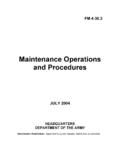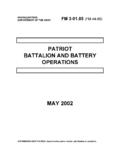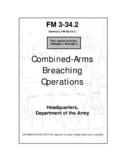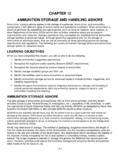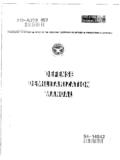Transcription of AMMUNITION HANDBOOK A Guide for Ammunition …
1 Field Manual*FM 9-13No. 9-13 HEADQUARTERSDEPARTMENT OF THE ARMYW ashington, DC, 4 November 1986 AMMUNITION HANDBOOKA Guide for AMMUNITION SpecialistsPREFACEFM 9-13 is intended to serve as a ready reference forammunition specialists and supervisors during trainingor when assigned to an AMMUNITION support unit oractivity in the field. It is not to be considered a compre-hensive textbook on AMMUNITION , but it does provideuseful data on important points of AMMUNITION servicesupport in the field. These data are equally applicable inpeacetime and manual covers safety, and the storage, main-tenance, handling, receipt, issue, turn-in, destruction,and transportation of AMMUNITION in field storagefacilities. The requirements of this manual apply to unit,commands, and installations of the US Army. They donot apply to subcommands, installations, and activitiesunder direct control of the US Army Armament,Munitions, and Center proponent of this publication is HQ, changes for improving this publication on DAForm 2028 (Recommended Changes to Publications andBlank Forms).
2 Forward to Commandant, US ArmyOrdnance Missile and Munitions Center and School,ATTN: ATSK-TPD, Redstone Arsenal, AL 35897-6600.* This publication supersedes FM 9-13, 28 January STORAGE OFAMMUNITIONThe purpose of field storage is to provide ammuni-tion to Army tactical units. Unlike permanent, mag-azine storage, AMMUNITION assets in field storage aremost often stored on the ground on unimproved sur -faces. Munitions are placed in field storage catego-ries separated from each other by appropriate mini-mum field storage quantity distances (QD), whichare based on total gross tonnage per individual stor-age unit (see Appendix C for a DODIC conversionchart). This chapter describes field storage areas,storage categories, site selection for field storage fa-cilities, and storage systems and storage 2 FIELD STORAGE AREAST here are four areas where field storage is likelyto be used theater storage areas (TSA), corps stor-age areas (CSA), AMMUNITION supply points (ASP),and AMMUNITION transfer points (ATP).
3 THEATER STORAGE AREAThe TSA is in the communications zone(COMMZ) where the reserve stocks are stored. Itshould have direct access to rail networks or bewithin short line-haul distance from them. In peace-time, the TSA could consist of permanent storage fa-cilities, igloos, or bunkers. In combat environments,the TSA may be open STORAGE AREAL ocated in the corps rear area, the CSA normallystores up to 10 days of AMMUNITION . Being in therear, it is more fixed than the forward combat am-munition supply points (ASP) it supports. For thisreason, it can have more permanent storage facili-ties; however, this depends on the SUPPLY POINTASPS are in the corps forward area. They providedirect support to the combat division or portions ofthe division and must store about 3 days of ammuni-tion. The tonnage stored varies depending upon thetype of unit supported. Based on their mission, for-ward ASPS are usually temporary. This means am-munition is not stored in igloos or 2 AMMUNITION TRANSFER POINTThe ATP is a transfer point in the brigade division AMMUNITION officer (DAO) has controlof all division ATPs.
4 ATPs stock high-tonnage, high-usage items. Since this is a transfer point, commonfield storage principles addressed in this manual donot apply. For the purposes of this manual, the ASPwill be spoken of most often because it is the mostcommon of the OF OPERATION STORAGES torage in a theater of operation, field storage,follows as nearly as possible the principles for stor-age in the Continental United States (CONUS).Such conditions as mobility requirements, scarce fa-cilities, or enemy air power vary a great deal in thea-ters of operation. Thus the ideal of CONUS storage,including safety, cannot be fully met or so, explosives and AMMUNITION may be satisfac-torily and safely stored in the theater if CONUS reg-ulations are adapted to field conditions. Detailed in-formation on theseadaptions is in CATEGORIESS torage categories are the primary groups intowhich AMMUNITION is segregated for storage in thefield.
5 The groupings are based on:How desirable it is to store components of com-plete rounds in adjacent hazards of spreading 2 The range of spread of AMMUNITION . For storage, con-ventional AMMUNITION is divided into categories Athrough G as follows:Category A. Fixed and semifixed artillery am-munition, except incendiary and B. Propelling charges, fuzes, primers,flash reducers, and separate loading artillery pro-jectiles including high explosives (HE) andarmor piercing (AP) but not incendiary andchemical C. Mortar AMMUNITION and hand gre-nades, except incendiary and D. Pyrotechnics and chemical ammu-nition of all types, including chemical filled rock-ets; gas, smoke, and incendiary bombs; gas andsmoke artillery AMMUNITION ; incendiary andchemical grenades; smoke pots; VX-filled mines;and bulk-packed incendiary and small-armstracer E. All demolition explosives, antitankand antipersonnel mines (except VX loaded),and components such as blasting caps, firing de-vices, detonating cord, and safety F.
6 Rockets, rocket motors, and riflegrenades, except G. The following items of US AirForce Class V supply, all unfuzed high-explosivebombs, aircraft mines, aircraft torpedoes, and23 chapter 2fragmentation bombs; fuzes and/or primer-detonators for the above items; and fragmenta-tion bomb clusters, fuzed or unfuzed. The re-mainder of Air Force Class V items must bestored in other proper storage, specialammunition is divided into the following generalcategories:Inert material such as missile and large (heavy)rocket bodies (less rocket motors) and test andhandling equipment for nuclear and rocket material such as detonators, HE warheads,and HE components of explosive categories help provide the basis for safetyprocedures for AMMUNITION storage. Four of the mostimportant items with the same storage risksare grouped together in the same each storage category, QD tables (seeTable 2-1) are the Guide for the maximum quan-tity of AMMUNITION to be stored within eachstack and within each field storage unit (FSU)and the minimum distance between stacks, FSUsand 2 Most often, only one kind of AMMUNITION isstored in a stack.
7 If more than one kind is storedin a stack, use the storage compatibility mixingchart in TM 9-1300-206 (Chart 5-2). Be sureammunition is stacked so it is easy to inventoryand inspect. Where camouflage is necessary (seemore on camouflage later in this chapter ), stepstacks in towards the top (terraced or pyramidstacking) to cut down shadows. Store compo-nents of complete rounds within the same FSUwhen arms AMMUNITION may be stored with anycategory with one exception. Bulk packed incen-diary and tracer cartridges must be stored in cat-egory SELECTIONT here needs to be a primary site and an alternatesite planned Site. When selecting a primary site,the following criteria are important. Try to incorpo-rate as many of them into the site as possible. Theyare listed in order of area is easy to get to by the area is near the main supply route (MSR)with access roads into the ASP. A roadnet within the site allows vehicles totravel under all weather conditions and requireslittle or no ground is as level as possible.
8 It must beable to support the weight of the AMMUNITION aswell as be able to drain off quickly. This also25 chapter 226 chapter 227 chapter 2makes it easier for MHE to operate. More onMHE later in this should be natural barricades that can sep-arate FSUs and site should be isolated from hospitals andimportant military site should be unpopulated and downwind ofany populated areas if any hazardous chemicalsare should be an adequate water supply forfire fighting and should be a minimum of should be features, including natural con-cealment, that make the site easy to defendagainst enemy ground area should be large enough to spread outammunition stocks. This protects them againstartillery or air attack and makes it easy of tactical conditions and other influenc-ing factors, an ASP site may not have all ideal fea-tures. In fact, higher headquarters may dictate wherean ASP will Site.
9 Pick an alternate ASP site closeto the primary one, because there maybe some otherunit already in the primary site. Another considera-tion: the enemy may attack with artillery, mortarfire, or chemical agents as soon as the primary ASPis set up, and the unit may have to evacuate fast. Fi-nally, some units have used their alternate sites as28 chapter 2regular ASPs when their stockage objective expanded-far more than they SYSTEMSA fter the site is selected, consider what system touse. There are several basic methods for storage ofammunition in the field. Consider the following:The physical characteristics of the hostile forces, uniformed or clandestine, the weather is expected to time and resources expected life of the space available and what type operation willmost easily allow following QD movement of vehicles throughout the stor-age complex. Vehicles must be able to pass othervehicles being loaded or unloaded.
10 There shouldbe no dead-end roads requiring backing or turn-ing roads should be stabilized to withstand traf-fic up to fully loaded 40-ton STORAGEIn this system, the area is divided into three sec-tions and subdivided into FSUs and stacks. Ammu-nition is stacked and is spaced to meet QD require-ments, ending up looking like a checkerboard. Thissystem provides efficient use of the total area, but itmay require a lot of road and pad construction andstabilization of the 2 ROADSIDE STORAGEThis system allows AMMUNITION to be stored instacks along the edges of existing roadways. FSUsand sections are spaced according to QD require-ments. Effective use of this method requires a largeroad network and a total area much larger than thearea system needs. However, little construction isnecessary. A variation of roadside storage, known as storage in depth, is very useful if the existing roadnetwork is limited. In this method, one or more addi-tional stacks of AMMUNITION are stored behind theroadside stack, away from the road.

